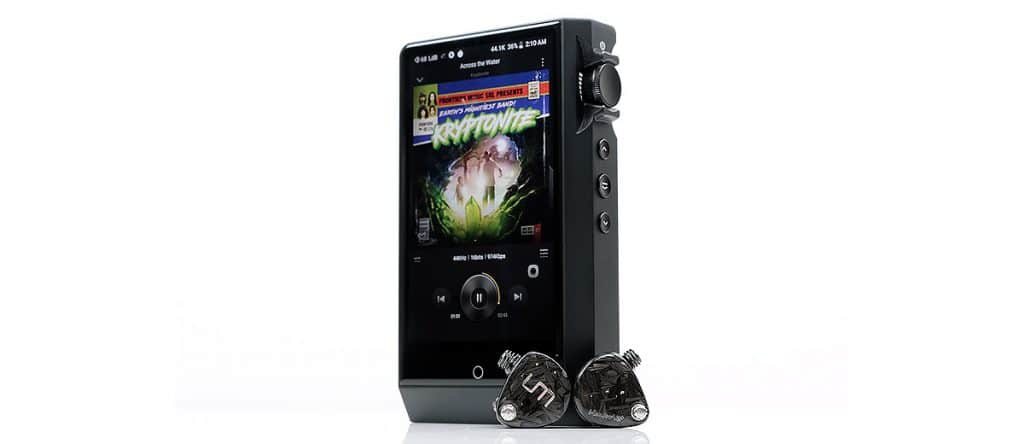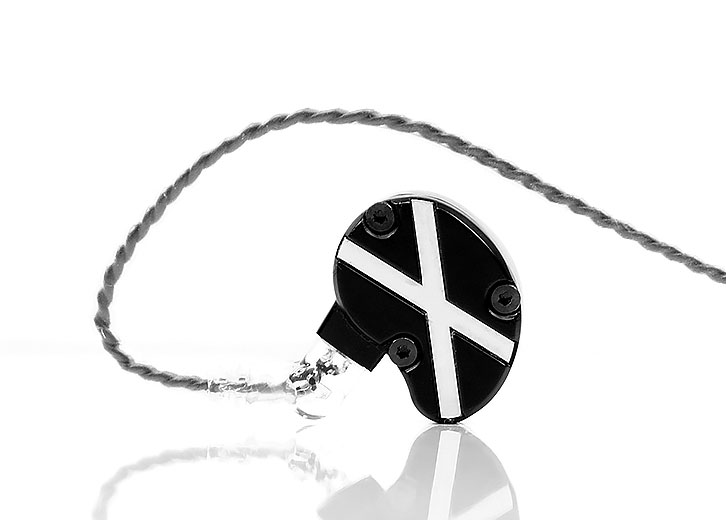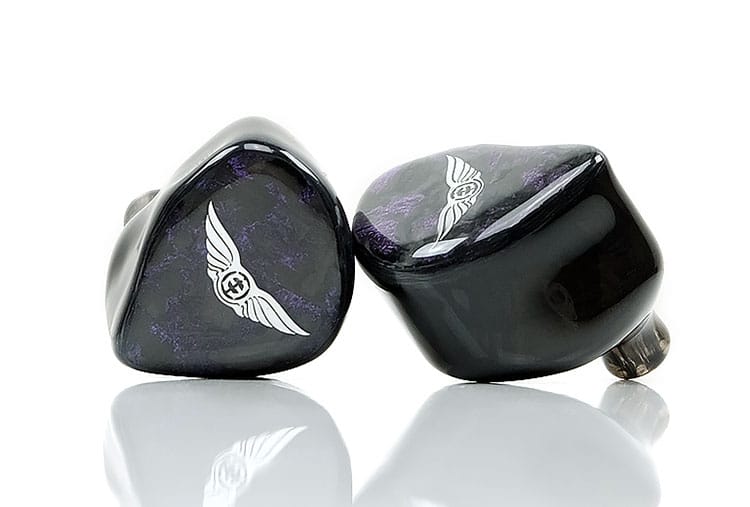Sound Impressions
Summary
You can check the detailed difference between the Mentor and Mason V3+ below in our comparison section but suffice to say they have very different signatures. The Mentor V3+ is lively, punchy, aggressive and thoroughly V-shaped but in a good way.
This is the type of coloration built for fun and it also sounds fast, faster than the Mason V3+ for sure. It also sounds more intimate in part, especially for vocals that pitch closer to the 1-2k range onwards that balance really well with that energetic mid-bass performance.
That low-end is also on the more intimate side at times with a forward punchy sound. However, it doesn’t carry too much warmth into the lower-mids despite that mid-bass kick. That’s a key difference also from the Mason V3+ which offers a more sustained bass elevation into the mid-bass around 100-250Hz.
UM has also tweaked the upper mids and treble with just enough presence to balance out the forward BA low-end. You get a nice level of sparkle and excellent upper-mids presence. Percussion notes have plenty of focus on the V3+ along with female vocals.
Male vocals 1k and downwards drop back a bit but the impressive clarity and instrumental separation the Mentor V3+ offers prevents lower-pitching vocals from ever sounding veiled.
Preferences
Honestly, the Mentor V3+ is tailor-made for modern pop and EDM in 2019-2020. That genre of music that’s got a sparse mix in the mids, a forward vocal, heavy on the low-end and a smattering of treble cues. Think Toxic Avenger, The Chainsmokers, and pretty most of the Prince back-cat will work also with the Mentor V3+. The PRaT is strong with this one if you keep the mids mix to a minimum.
Tips
I think it is important to note some factors that will affect the core Mentor V3+ sound signature. Tips will have a huge influence here.
The stock Comply tips will tone down the high-end energy and inject a bit of body and wetness into the Mentor V3+ timbre. The silicone tips will thin it out, bring in a lot more treble energy and tip the balance more in that direction.
My personal preference is a little on the foam side or the silicone tips with the Cayin N6ii/A01 combo. It can get hot up there with the Mentor V3+/LPGT and silicone tip combo. Some might like that but me, I prefer the thicker richer sound the foams offer. You still get nice energy from the upper mids and treble but it is not so aggressive. Slipping into silver cable mode with the foams is spot on with excellent clarity.
Staging
The staging is relatively tall and deep but with better than expected width. I actually like the level of clarity UM has injected into the Mentor V3+ soundstage. The instrumental separation and imaging capability in the mids are actually well above average for what I would expect for a V-shaped tuning.
I would still opt for the Mason V3+ experience though if you want a truly open or wide midrange. Here, UM are working within a more constricted midrange but the tipping forward of the vocals from 1-2k onwards stretches the staging nicely. Combine that with excellent imaging and a good treble extension and the Mentor V3+ does an excellent job creating a good perception of space and depth.
Bass
If you noticed the insertion of “BA” in the low-end summary description that’s not a random statement. This is a low-end with BA timbre so it is not subterranean deep or with a typical dynamic driver long decay.
However, it is one of the better BA tunings for bass and it can sound visceral when called upon. It is relatively quick-paced also which heightens the perception of a good fundamental underlying most thick synthy type bass mixes.
Sub-bass has a decent weight but its mid-bass punchiness around 100-150Hz that is the main calling card for me. That’s what drives the Mentor V3+ overall presentation. The layering is also very impressive on the low-end with some really good definition.
DB-GO
The 4dB bass boost is still relatively mild but that’s a good thing for the Mentor V3+. I really do not want the low-end to overpower the mids with its stock tuning.
What I do get a bit more mid-bass warmth with the 50-100Hz range sounding a little fuller and more planted sounding. I tend to turn this one up when moving to dark synth-wave tracks or i want a little more richness in my low-end timbre.
Mids
From around 100-200Hz, the Mentor V3+ tuning takes a drop into the lower-mids that sucks the warmth and a bit of body out of instrumental timbre. However, the resolution, speed and most critically, instrumental separation is excellent.
Quite often I get V-shaped monitors that smear all over the place up to around 1-2k so you get this gloop of thick warm notes but not a lot of definition. Not so with the Mentor V3+. The lower-mids retain a lot of clarity despite their dipped positioning behind upper mids percussion and vocals.
Male vocals really benefit from that clarity also. They are not the most forward in the mix, especially below 1k, but I can hear them clearly and they have enough air to breathe also.
The V3+ timbre really helps here also. It is not too thick or even harmonic dominant so you don’t get the dreaded veil. Actually, the harmonic balance of both instruments and vocals are quite natural to neutral sounding for me, especially with the foam tips on.
Upper mids are lifted and energetic but not overly shouty. Again, I advise the foam tips and silver side of the dual-tone cable for the best match here. The silicones leave them too thin and bright for my tastes. You will start to get a bit more odd-harmonic influence here so percussion sounds lively and forward as for female vocals. However, the treble tuning is excellent and not overdone so it is not splashy or sibilant.
Treble
A really good BA treble tuning. Not a brittle sound, not overly laid back and wet either. It is right in the middle with a coherent tuning through the lower treble and a slight fade beyond 8k, or a less of a nudge so to speak.
Either way, it doesn’t sound ethereal or lean and that helps percussion hits sound clean but with enough sustain and texture to avoid being brittle ‘weak sauce’.
That treble energy does creep into the mids timbre but that’s ok. Quite apart from giving instruments a nice clean edge it also prevents a nice ‘exciting’ contrast to the mid-bass bump.
Synergy
The Mentor V3+ is rated at 18.9Ω and 113dB SPL which places it on the sensitive side of things but not super-sensitive like the Solaris or Andromeda level. It is more sensitive than its co-flagship monitor, the Mason V3+ rated at 107dB SPL.
It is not so demanding of most DAPs and it will also avoid higher noise floor background hiss so the synergy for the Mentor V3+ is excellent. My only tip is to pick a DAP that can deliver a high level of dynamic range or a punchy low-end to get the best out of the sound signature.
The N6ii with A01, for example, left me wanting on the low-end because of its softer and more restrained delivery. The same also with AMP 1 MKII on the iBasso DFX220. PMEQ and MSEB on both DAPs will help as well as switch on the DB-GO module to full-pelt.
I ended up with the Lotoo PAW Gold Touch and 6000 because of their clarity and the R2R2000 Red because of the really dynamic treatment of the vocal range and imaging with the Mentor V3+. You can go R2R2000 Black also but the Red has a nice warm hue to the timbre that works wonders with the Mentor V3+ vocal timbre.
Select Comparisons
Unique Melody Mason V3+
$3199
Technical
The Mason V3+ is the co-flagship monitor to the Mentor V3+ and retails a little higher at $3199. I guess some would say that’s really the flagship if we base it on price. The Mentor, like the Mason V3+, is also an upgrade or change from the original Mason V3, which we reviewed in 2017.
This is a 16 driver, as opposed to 12 drivers balanced armature configuration. Both use a 4-way crossover but given the different driver numbers, the configuration is different. The Mason V3+ uses 4 low, 4 mid-low, 4 mid-high and 4 for the highs. The Mentor configuration is 4 low, 2 mid-low, 2 mid-high and 4 for the highs.
The Mason V3+ I have here is a custom design so it is bigger but the seal is 100%. The Mentor V3+ sample here is universal so a longer nozzle and tip-dependent. However, both share a lot of similar tech with DB-GO modules, that tasty looking carbon fiber Dreamweaver shells and the dual-tone cable.
Performance
The Mason V3+ has a similar impedance at 19.6Ω compared to the Mentor’s 18.9Ω. However, the sensitivity levels between these two have a bigger gap at 107dB for the Mason V3+ and 113dB for the Mentor V3+. I can only presume the Mason V3+ has some less efficient BA drivers in there somewhere.
What that does mean is that the Mason V3+ requires a bit more current for volume levels over the Mentor V3+ but otherwise, both should be comfortable enough on most DAPs. Personally, I would pick a clean neutral DAP for the Mason V3+ fulsome sound and a DAP with good dynamic range for the Mason V3+’s lively signature.
Tuning
The Mentor V3+ is quite the contrasting presentation to the Mason V3+ and honestly, you should not have any issues deciding which one suits your preferences best.
The Mentor V3+ is a lively affair with a slight v-shaped tuning favoring snappy lows and sparkling highs over the mids but not hugely so. There is a bit of mids lift for vocals.
The Mason V3+ is more relaxed but thicker sounding with more mid-bass warmth. You will perceive more body and a richer timbre on the Mason V3+ but also you will get a little less treble energy and presence. Both offer a BA type timbre but it is just the differing emphasis that is critical.
In terms of staging, both have the same low-end extension but the Mason V3+ sounds a fuller whereas the Mentor V3+ bass is more forward, aggressive and intimate. The Mason V3+ is less dipped in the lower-mids but not as forward for vocals. The Mentor V3+ has more treble extension and forwardness so its airier and that helps vocals to breathe.
Also, that V3+ treble presence delivers a bit odd-harmonic presence so it is not as euphonic or thick sounding through the mids as the Mason V3+. I would pick the Mentor V3+ if you wanted more sparkle and extension beyond 7k. Pick the Mason V3+ if you want more instrumental smoothness and lower-mids presence as well as sub-bass girth over mid-bass punch.
CTM Da Vinci X
$2400
Technical
The Da Vinci X is the flagship universal monitor from Florida-based CTM. It is marginally cheaper than the Mentor V3+ at $2400. This is a 10-driver monitor and an all-BA internal design. There are no similar features such as DB-GO bass tweaking or switchable cables.
Instead, The Da Vinci X the configuration is 4 for the lows, 4 for the mids and 2 for the highs with a 5-way crossover. The Mentor configuration is 4 low, 2 mid-low, 2 mid-high and 4 for the highs with a 4-way crossover.
I have to favor the Mentor V3+ design here. Both universals have some unique individual flair but the smoother carbon fiber Dreamweaver design with DB-GO is more complex and attractive than the X-adorned harder-edged aluminum of the Da Vinci X. The Da Vinci X looks tough as nails though so I have no issues with its ability to take some knocks but it is not as comfy in the ear as the Mentor V3+.
The cable on the Da Vinci X is their own $180 Juba hybrid which is a 4-wire Hybrid Copper/Silver Alloy with a 2.5mm TRRS finish. It is a lot lighter and quieter than the 8-wire Mentor V3+ cable being half the core count but it has no switching tone capability.
Performance
The Da Vinci is rated at 43.8Ω and 117.2dB compared to just 18.9Ω and a close 113dB for the Mentor V3+. There should not be too much separating them on paper with a decent DAP to look after that slightly higher than average impedance rating on the Da Vinci X. The Mentor V3+ is a shade less efficient for current but the gap is not huge.
We tested them both out of a Lotoo PAW Gold Touch balanced and there was just the tiniest uptick in volume of the Da Vinci X. However, that was more due to my wanting more “oomph’ from its low-end than any huge volume deficit.
Suffice to say neither really huge power to get them running optimally and most resolving DAPs will sound just fine with these two monitors.
Tuning
The Da Vinci X is more neutral-sounding and balanced sounding than the V3+. It will struggle a bit for texture and good body sub-100Hz though it is not without a little bit of thud and there is a slight elevation form 60-100Hz.
Still, far more linear sounding than the denser and heavier sounding low-end of the V3+. Both still have a BA timbre so its not dynamic driver low-end depth but the V3+ is punchy, livelier and warmer than the Da Vinci.
The mids are where the Da Vinci X excels with a slight bias to the 1-2k zone so everything is crystal clear, with excellent separation and above-average staging width. The Mentor V3+ is more vocal lifted with instruments a little diminished in the lower-mids and emphasized on the upper mids.
Staging Depth
One thing I would like to note about staging depth with these two monitors. The Mentor V3+ goes for power to create that absolute sense of depth because the mids are a shade narrower. The Da Vinci X creates a sense of staging depth through better instrumental separation and placement.
Treble is more forward on the Da Vinci sounding airier with better headroom. You still get some treble energy with the Mentor V3+ but the overall sound is wetter than the Da Vinci X. Especially if you use the foams. The flipside is the X percussion timbre is a bit leaner sounding than the fuller notes of the Mentor V3+. That can grate on more sensitive ears.
Empire Ears Wraith
$3499
Technical
The Wraith is Empire Ear’s flagship hybrid universal monitor consisting of 111 balanced armature drivers and no less than 4 Sonion electrostatic drivers. And it is more expensive than the Mentor V3+ by almost $1k.
Naturally, a different configuration between these two with the Wraith using 2 BA for the lows, 3 for the mids, 2 for the highs and the quad e-stats for the super highs. The Mentor V3+ 12 driver configuration is 4 low, 2 mid-low, 2 mid-high and 4 for the highs. The Wraith uses a 5-way compared to the 4-way crossover of the Mentor V3+.
Since both are universal both can be compared including the supplied cables. The Wraith is just a shade narrower but deeper on the main shell with a shorter nozzle. The EE design is also a more subdued standard acrylic. The carbon fiber Dreamweaver shell of UM should be marginally more durable. The Wraith lacks any tweaking capability such as the DB-GO module but it does come packed with the fantastic Effect Audio Cleopatra cable.
I like the dual-tone cable the Mentor V3+ comes with its 6N 4-core single crystal copper and 6N 4-core silver, (combined for 8-core) switching flexibility. However, the Cleopatra UP-OCC Pure Silver 26AWG Litz build is lighter and quieter when handling. The finishing is also a grade higher than the dual-tone Mentor V3 cable.
Performance
The Wraith is rated at a wildly low 4Ω and a fairly high 117dB SPL. Compared to the more mundane numbers for the Mentor V3+, the Wraith should be really easy to drive. In our actual testing, this turned out to be fairly accurate with the Wraith being more sensitive than the Mentor V3+ and requiring less volume.
Both ran just fine unbalanced from the N6ii and balanced from the Lotoo PAW Touch Gold but I suggest going for punchier more dynamic sounding DAPs such as the Lotoo. The N6ii was overly smooth with the A01 for me, especially with the Wraith.
Tuning
The Wraith is more of a mid-centric and performer with a bit of sub-bass depth and mid-bass warmth secondary. The V3+ is v-shaped with of a low-end and mid-bass punch, elevated vocals and a bit more treble sparkle, at least in the mid-treble 6-7k region. Both of these are IEMs are not what you would call reference monitoring.
One key difference between the two of them right away is the treble bias. You can hear that BA timbre on the Mentor V3+ treble and whilst I do not hear it as being overly sizzling, especially with the foam tips, it is a bit more brittle than the Wraith treble.
However, the Wraith treble tuning is very laid back or on a downward curve so it is much wetter, smoother and lacking in the same headroom and sparkle as the V3+. If you want your percussion with more presence then the V3+ has more of that.
Vocals
Vocals on both are forward but the Wraith vocals are a shade smoother and fuller sounding and certainly, of the two this would be the one I pick for vocal performances. The V3+ vocals are cleaner but slightly less body on them and male vocals lower-down are more recessed than female.
Bass has more weight and body on the Mentor V3+. The Wraith has more weight and punch than the Da Vinci X but its more controlled and not as extended sounding as the Mentor V3+. The V3+ is really tuned to deliver a heavier low-end.
Our Verdict
The Mentor V3+ is an excellent V-shaped sounding monitor. Though not reference class it is well above the regular V-shaped stuff out there with impressive midrange imaging and a nice vocal presence to go along with that punchy low-end and finely balanced treble.
Driver counts do not really matter but they can do if you know what you are doing with them and it seems UM has learned a lot from the original Mentor V3 released a few years ago. The stunning design visuals also look, for want of a better word, ‘Maleficent’, with that dark carbon fiber and gold speckled finish.
My only advice is that you also pay close attention to the tips. The tips will play a bigger role in the final sound signature of the Mentor V3+ than either the DB-GO and dual-tone cable swapping with the foams and silver cable side presenting the best balance for me.
A fun sound, but tastefully done I would argue.
Mentor V3+ Specifications
- Frequency response range:20Hz-30KHz
- Sensitivity:@1KHz 113dB
- Impedance:18.9Ω
- Driver Count:12BA
- Crossover:4-way crossover system
- Driver Configuration:4 low+2 mid low+2 mid high+4 high






